Learn Hiragana chart
Are You Excited to Learn Hiragana chart? When you study hiragana, you are laying the groundwork for the remainder of your Japanese language skills. Your knowledge of hiragana will provide you with a foundational understanding of Japanese pronunciation.
The Japanese resources that you may utilize will also become more accessible to you as a result of this. In the Japanese language, there are no excellent textbooks or other learning tools that do not require you to be familiar with hiragana. It is, in essence, the first stage in the process of learning Japanese.
Hiragana Chart Worksheet.
|
A |
I | U | E | O |
| あ | い | う | え |
お |
This column is the first one in Hiragana, and it is also the most significant one! Every other column is essentially just the a-i-u-e-o column with consonants added, so it is responsible for establishing the pronunciation of all subsequent columns. Remember that the same fundamental sound is repeated repeatedly, with a consonant in addition to these five vowel sounds; thus, you must have the correct pronunciation for these five vowel sounds right from the beginning.
Do you agree? I’m sorry, but that’s OK, after you.

あ is pronounced like “ah!” like when you come to a realization. It also sounds like the a in “car.”
- あ
- A
To remember this kana, find the capital A inside of it. This “A” will tell you that this kana is also “a” aka あ. There is another similar kana, お, but that one doesn’t have an “A” in it, which is how you can differentiate them.

い is pronounced like the ee in “eel.”
- い
- I
To remember this kana, just think of a couple of eels hanging out. They’re upright because they’re trying to mimic the letter “i” which also stands upright and also happens to be the way you spell out this character in romaji.

う is pronounced like the oo in “ooh… ahhh!” when you’re watching fireworks. In other words, it sounds like u in “UNO,” the card game, or the number one in Spanish.
- う
- U
To remember this kana, notice the U shape right in it! It’s sideways, but it’s there, telling you what this kana is. Be careful, there’s another similar hiragana, つ, but that one isn’t wearing a hat like U (you) are. Ooh, ahh, what a nifty hat!

え is pronounced like the e in “egg.”
- え
- E
To remember this kana, think of it like an exotic bird. The feathery thing on its head gives it away that it’s exotic and not normal. It also lays exotic eggs, because it’s an exotic bird, after all.

お is pronounced like you’re saying “oh.” It also sounds like the o in “origami.”
- お
- O
Can you see the letter o in here, two times? This one looks similar to あ, except for its one key difference: there are two letter “o” symbols visible in there. Make sure you use this to differentiate this kana (お) and that similar kana (あ). This is one area of hiragana where a lot of people trip up, but by using this mnemonic you will be able to figure them out every time.
あいうえお Tasks
Now that you’ve put these kana into your brain (at least somewhat shakily) it’s time to pull them out. Recall is the foundation of memory, and you’re going to start doing just that. For each “tasks” section make sure you follow along perfectly. Skipping these steps may cause you to fail later on in the future. Having a strong base to build off of is important with each section.
- Head over to Japanese Hub Learn Hiragana Quiz. Select only the
あ/abox under the “Main Kana” list, then hit “Start Quiz!” and keep practicing until you can get them all right. - Print out, copy, or download this worksheet. You’ll need to go through it, filling in the boxes with the romaji for the kana. Try your best not to cheat – even if you spend a while trying to remember a kana it will be beneficial to your memory (as long as you’re able to recall it on your own). Looking up the answer doesn’t help your memory at all, but struggle (with accomplishment) tells your brain that this is a thing worth remembering. Try using the mnemonics when you need to recall something you can’t figure out right away. This should be fairly easy with only five kana (and maybe a little boring too), but when you’re done move on to the next five hiragana.
|
KA |
KI | KU | KE | KO |
| か | き | く | け |
こ |
The next set of hiragana is from the “k-column.” This is just the K sound plus the vowel sounds you learned above, making it ka-ki-ku-ke-ko. There are no weird exceptions in this column either, so enjoy it while you can.

か is just the K sound plus あ, making a ka sound. It’s pronounced like ka in “karma.”
- か
- KA
See how this kana looks like a mosquito? What a convenient coincidence. Mosquitos happen to be called か (ka) in Japanese. You also say “cut it out, darn mosquito!” when they try to suck your blood, so that should be easy to remember.

き is just the K sound plus い, making a ki sound.
In fact, it sounds just like the word “key” which is the mnemonic we end up using.
- き
- KI
To remember this, notice how much it resembles a key.
Note: In some fonts, the bottom part is detached from the main part. For example: き. The pronunciation is still “ki” though!

く is just the K sound plus う, making a ku sound. It’s pronounced “coo,” like both syllables of the word “cuckoo” (or just the first syllable, depending on your variety of English).
- く
- KU
To remember this, think of this kana being the mouth of a coo-coo / cuckoo bird popping out saying “ku ku, ku ku!”

け is just the K sound plus え, making a ke sound. It’s pronounced like ke in “kelp.”
- け
- KE
See how this kana resembles some wiggly kelp?

こ is just the K sound plus お, making a ko sound. It’s pronounced like co in “cohabitating.” In British English, it is more like co in “coin.”
- こ
- KO
こ is a couple of co-habitation worms. They’re so happy together, co-habitating the same area! Alternatively, you could imagine a couple of short cords laying on the ground next to each other.
かきくけこ Tasks
More tasks! This time we’ll include the あいうえお column along with this “K-column” you just learned.
- Using Japaneshub Learn Hiragana Quiz, select the
あ/aandか/kaboxes, and quiz yourself on those cards. How quickly can you identify and answer these ten hiragana characters? When you’ve completed this task at least five times, move on to the next step. - Print out, copy, or download this worksheet. Complete it by filling in the blanks with the romaji for each of the kana. This time it will be both of the columns that you’ve learned (so far) so it should be a little more interesting (and half familiar).
Once again, when you get stuck just think back to the mnemonic before you cheat. When you’re done you can move on to the next group.
|
SA |
SHI | SU | SE | SO |
| さ | し | す | せ |
そ |
Now that you have the “K-column” under your belt it’s time for the “S-column.” There is one weird exception in this column, and that’s for “si” aka “shi.” It’s pronounced just like the word “she” in English, and doesn’t quite follow the pattern you’ve seen up until now. You’ll want to use “sa-shi-su-se-so” for this column.

さ is just the S sound plus あ, making a sa sound. It’s pronounced like sa in “salsa.”
- さ
- SA
Notice how this kana looks like two hands stirring a bowl of salsa. This salsa is so chunky and thick, you need two hands just to stir it!
Note: Like き, the bottom part of さ is detached from the main part in some fonts. For example: さ.

し is just the SH sound plus い, making a shi sound. It’s pronounced like shee in “sheep.”
Take note that this is the first “exception” kana where it doesn’t follow the patterns that show up everywhere else. Instead of being “si” it’s “shi” (though you will see it written both ways when dealing with romaji. One more reason why you ought to just learn hiragana already).
- し
- SHI
This kana looks like a giant shepherd’s crook used to herd sheep. Baaaa… get in that corral, sheep!

す is just the S sound plus う, making a su sound. It’s pronounced like the word “sue,” or su in “suit.”
- す
- SU
See the swing doing a loop-dee-loop throwing that poor kid off of it? Imagine him screaming “I’M GONNA SUE SOMEBODY FOR THIIIIIiiiissss” as he flies off into the distance.

せ is just the S sound plus え, making a se sound. It’s pronounced like se in “sell.”
- せ
- SE
This kana looks like a mouth with a big vampire fang in it. Someone’s trying to sell you a set of vampire teeth because they are just so sexy! Oh Dracula, always trying to make a quick buck.

そ is just the S sound plus お, making a so sound. It’s pronounced like so in “soda.” In British English, it’s more like so in “song.”
- そ
- SO
See how this kana looks like a mouth slurping soda?
さしすせそ Exercises
Now that we’ve done three sets of five, it’s time for exercises! As usual, these exercises will help you to practice kana you’ve previously learned plus the ones you just learned.
- Back to Japaneshub Learn Hiragana Quiz. Select the あ, か, and さ boxes and quiz them. Do this five times. Once you’ve done this, move on.
- Using this worksheet, print out, copy, or download it and fill out the boxes with the correct romaji. If you can’t remember something try to think back to the mnemonic first before cheating.
When you’re able to do these two tasks move on to the next five kana.
P.S. Have you noticed how in the worksheets you’re being asked to wait 5 minutes then 10 minutes? Waiting is actually an important part of building memory. By waiting and then recalling something as it’s fading away, you’re telling your mind that it shouldn’t forget that item. But, if you keep bringing it up over and over again in a short period of time your brain will just keep it in its short term memory, meaning you probably won’t remember it later. Don’t skip the waiting periods! In fact, if you think you can wait longer without forgetting much that’s even better!
|
TA |
CHI | TSU | TE | TO |
| た | ち | つ | て |
と |
Time for the fourth column, the “T-column.” Now you have a lot to remember! Hopefully mnemonics and the reasons for using them are starting to make sense now. If not, that should happen soon.
Like the さ column, you’ll find an exception in the た column. In fact, you’ll find two exceptions, them being ち (chi) and つ (tsu). So, for this column we’ll have “ta, chi, tsu, te, to.”

た is just the T sound plus あ, making a ta sound. It’s pronounced like ta in “taco.”
- た
- TA
Use your imagination and see this kana as a fork, taco, and lime garnish for your taco. Wait… you’re eating a taco with a fork? That’s a bit weird, but you do you, pal.

ち is just the CH sound plus い, making a chi sound. It’s pronounced like chee in “cheese.”
This is the second “exception” hiragana. Instead of a “ti” sound, it’s a “chi” sound. Try not to forget this.
- ち
- CHI
You know when someone tells you to say “cheese” when taking a picture of you? This kana looks like that forced smile you have to make every time you’re in a group photo.

つ is just the TS sound plus う, making a tsu sound. It’s pronounced like tsu in “tsunami.”
- つ
- TSU
This is another “exception” hiragana. Instead of saying “tu” you say “tsu.”
Look at the swoosh of this hiragana. Doesn’t it look like a big wave, or tsunami?
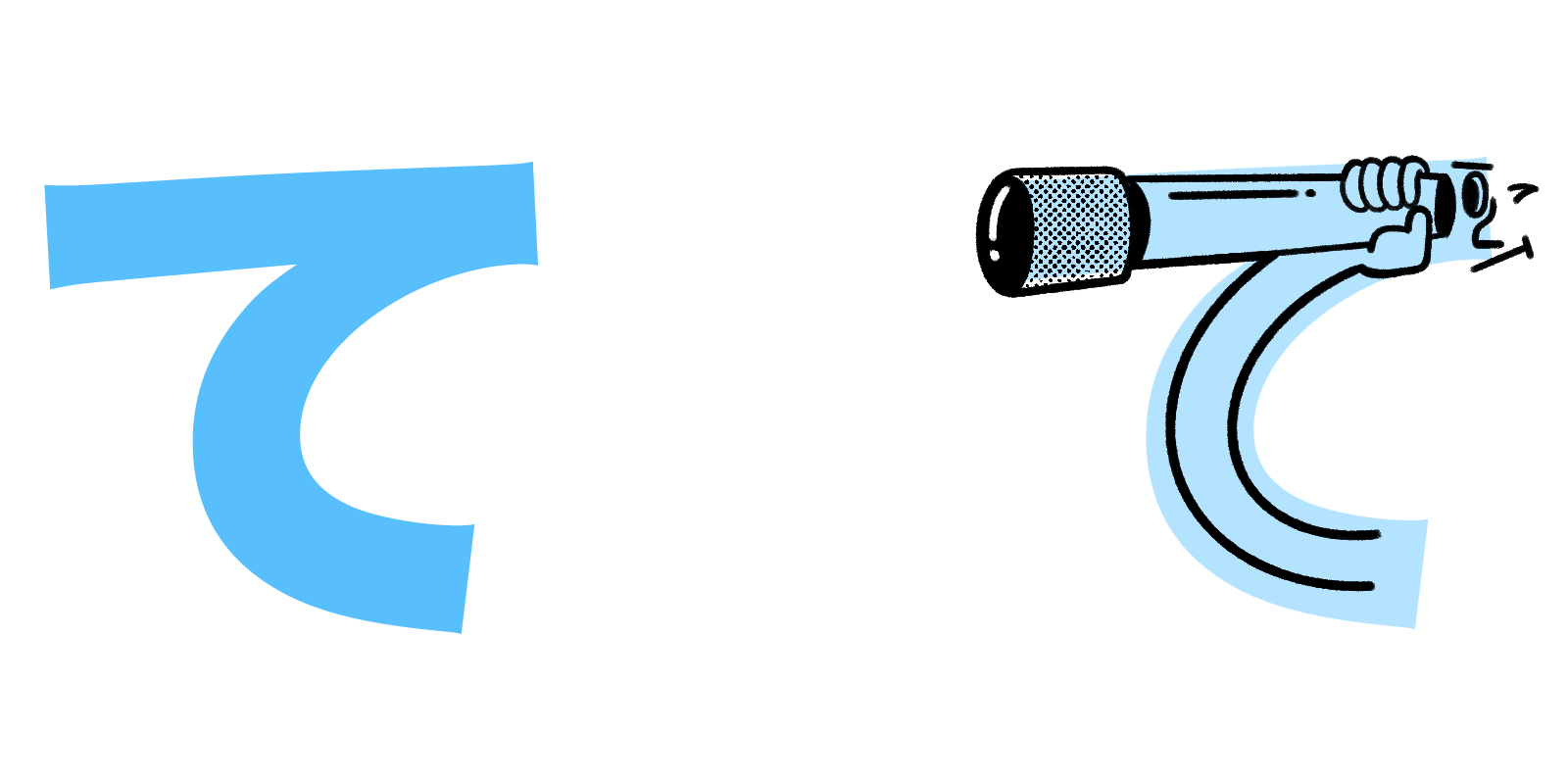
て is just the T sound plus え, making a te sound. It’s pronounced like te in “telescope.”
- て
- TE
Can you see a good ol’ telescope? It’s a hand-held one! In Japanese, “hand” is て (te). That should help you remember that this kana looks like an old-school hand(te)-held telescope.

と is just the T sound plus お, making a to sound. It’s pronounced like to in “toe.” In British English, it sounds like “to” in “top.”
- と
- TO
This kana looks just like someone’s toe with a little nail or splinter in it. Imagine how much this would hurt if it was your toe!
たちつてと Exercises
Now that we have a few kana under our belt we’ll be adding a third resource to our arsenal. Still, we’ll start with something familiar. Just follow along.
- With Japaneshub Learn Hiragana Quiz, quiz yourself on the four columns that you know (あ, か, さ, た). When you’ve done it five times, move on to the next step.
- Copy, download, or print out this worksheet. Fill in all the blanks with romaji. Pay special attention to “exception” kana, like し, ち, and つ and write them out the way I showed you above to make sure that you know the proper reading. Not all romaji-styles will write these kana like this (you’ll see “si, ti, and tu” too), but for now write “shi, chi, and tsu” just for the sake of associating the correct pronunciation with each of these particular kana.
When you’ve completed everything and feel like you can recall all 20 of these kana, move on to the next section. Now it’s time to try ten at a time. You’re getting better at this, after all!
|
NA |
NI | NU | NE | NO |
| な | に | ぬ | ね |
の |
This is your first “more than five things to learn” group. In fact, it’s a whole ten things! But you’ll be just fine. You’re getting better at learning the hiragana with all this practice. Too bad there’s not 150 hiragana for you to practice on.

な is just the N sound plus あ, making a na sound. It’s pronounced like na in “nachos.”
- な
- NA
The nun is praying in front of the cross asking for nachos, because she’s craving a delicious snack. The cross up in the air should be the main giveaway that this is な.

に is just the N sound plus い, making a ni sound. It’s pronounced like nee in “needle.”
- に
- NI
Do you see the needle pulling the thread?
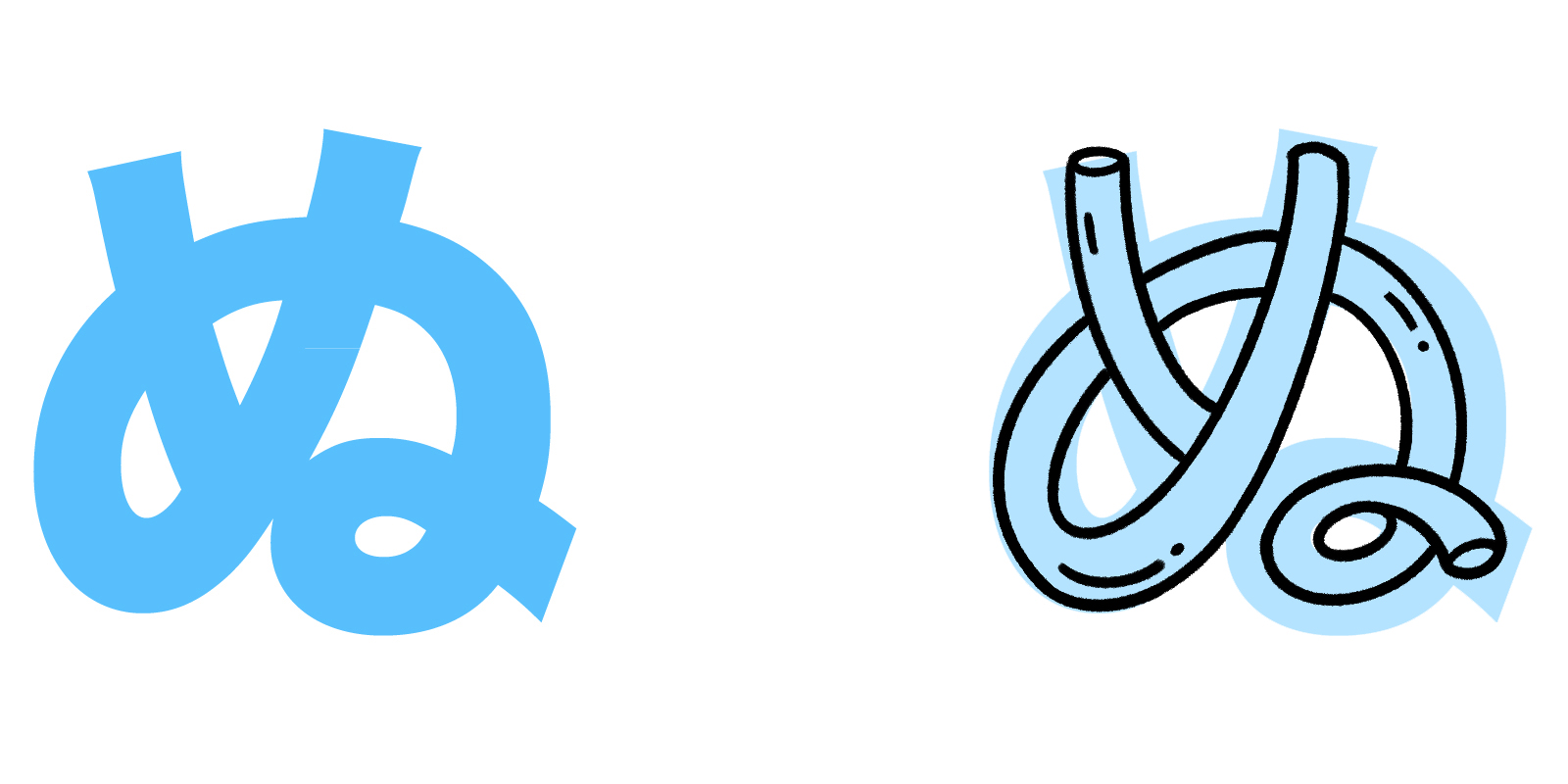
ぬ is just the N sound plus う, making a nu sound. It’s pronounced like noo in “noodle.”
- ぬ
- NU
This kana looks like some noodles. There are several other kana that are similar to this one (れ, め, ね, わ), but you know this one is noodles because there are no sharp angles in it. It’s 100% smooth and bendable, like noodles! It even has an extra loop at the bottom, because it is a noodle.

ね is just the N sound plus え, making a ne sound. It’s pronounced like ne in “Nelly.”
- ね
- NE
This is Nelly the cat. There are other kana very similar to this one (ぬ, れ, め, わ), but you know this is different. Why? Because it has a loop at the end for the tail, and it’s not super bendable like ぬ (noodles) is — see those sharp corners on the left?
To top things off, Nelly is a necromancer. Why? I have no idea, you’ll have to ask her. It must have something to do with the undead cat army she’s creating.
Also, if you know the word neko (Japanese for “cat”), you can use that too. This is a ねこ.

の is just the N sound plus お, making a no sound. It’s pronounced like no in “nose” or “nori.”
- の
- NO
See the big pig nose there? You can also think of this as a “No Smoking” sign (the ones with the cigarette and the big red circle and slash through it). Pick the one that sticks with you the best
|
HA |
HI | HU/FU | HE | HO |
| は | ひ | ふ | へ |
ほ |
Now let’s look at the next five in this set. If you’re feeling really shaky you can jump over to Learn Hiragana Quiz to practice, but you don’t have to (yet)!

は is just the H sound plus あ, making a ha sound. It’s pronounced like ha in “haha” (like laughing!).
- は
- HA
This kana looks like an uppercase letter H plus a lowercase letter a.
What does that spell? “Ha!”
Why are you laughing? Stop that. Make sure you can see the H + a in the kana.

ひ is just the H sound plus い, making a hi sound. It’s like the English pronoun “he.” In other words, it sounds like he in “heat.”
- ひ
- HI
He has a big nose. See that big nose? Now say it out loud. “He has a big nose.”

ふ is halfway between the F and H sounds, plus う, making a fu / hu sound. It’s pronounced like a softly blown-out version of foo in “fool,” or sometimes hoo in “hoop.”
- ふ
- FU
Someone is over there dancing like a fool. What’s that around their neck? …Oh, that’s a hula hoop! That’s why they’re twisting their body so hard.

へ is just the H sound plus え, making a he sound. It’s pronounced like he in “help,” or “Helens.
- へ
- HE
Do you know the famous mountain Mt. Saint Helens? This kana isn’t totally flat like Helens is, but it’s pretty squat looking. That’s why this one is Helens.

ほ is just the H sound plus お, making a ho sound. It’s pronounced like ho in “hoe” or “ho ho ho!” In British English, it sounds more like ho in “hot.”
- ほ
- HO
The line on the left is a chimney. The right side is a mutated Santa Claus. He has four arms, a snake tail, and no head. Out of his neck he’s uttering “ho ho ho… ho ho ho…“
Hopefully he doesn’t come down your chimney.
なにぬねのはひふへほ Exercises
Time to practice ten at a time! It’s a lot, but you’re getting better at learning these things, right?
- Using Japaneshub Learn Hiragana Quiz, quiz yourself on the hiragana from the あ, か, さ, た, な, and は columns. When you’ve completed this five times, move on to the next task.
- Copy, print out, or download this worksheet and fill in all the boxes. As always, use the mnemonics and try not to cheat. If this is starting to feel easy, try to time yourself to see how long it takes to complete each section and try to beat yourself each time.
When you are done with these exercises it’s time to move on to the next set of hiragana.
|
MA |
MI | MU | ME | MO |
| ま | み | む | め |
も |
Not quite ten in this set (before the exercises), but close enough. Let’s start with the “M-column.”

ま is just the M sound plus あ, making a ma sound. It’s pronounced like the English word “ma” (meaning “mother”). In other words, it sounds like ma in “mark.”
- ま
- MA
Removing your head? Doubling your hands and arms? What sort of evil magic is this? What makes it weirder is that your mama is the one doing this magic. Imagine your ma looking like this. Aghh!

み is just the M sound plus い, making a mi sound. It’s pronounced like the English word “me.” In other words, it sounds like mee in “meet.”
- み
- MI
Looks like lucky number 21. Who just hit the blackjack? Me! Who just turned 21 as well? Me!!

む is just the M sound plus う, making a mu sound. It’s pronounced like what cows say in English: “moo.” In other words, it sounds like moo in “mood.”
- む
- MU
“Moooooo“, says the cow. “MOOOOOOO.”

め is just the M sound plus え, making a me sound. It’s pronounced like me in “mess.
- め
- ME
Look at that beautiful eye! It’s so beautiful because of the makeup on it. Gotta look pretty in the eyes, or else your ensemble will just be “meh.”
If you also happen to know the word for “eye” in Japanese, that will help too. The word for “eye” in Japanese is just め (me).

も is just the M sound plus お, making a mo sound. It’s pronounced like mo in “more.”
- も
- MO
You want to catch more so you add more worms to your hook.
|
YA |
YU | YO | ||
| や | ゆ |
よ |
This column is a little strange. There are only three items in here, and “ye” and “yi” are seemingly missing. Actually, they used to exist but now they don’t (instead people use い or え, because it sounds pretty similar). Because of that, you only have to learn three kana for this section!

や is just the Y sound plus あ, making a ya sound. It’s pronounced like ya in “yacht.” In British English, it sounds more like ya in “yak.”
- や
- YA
See how this kana looks like a yacht with an anchor going down? It’s even got a little flag on the rear… how cute.
Alternatively, you can
think of や as the face
of a yak too.
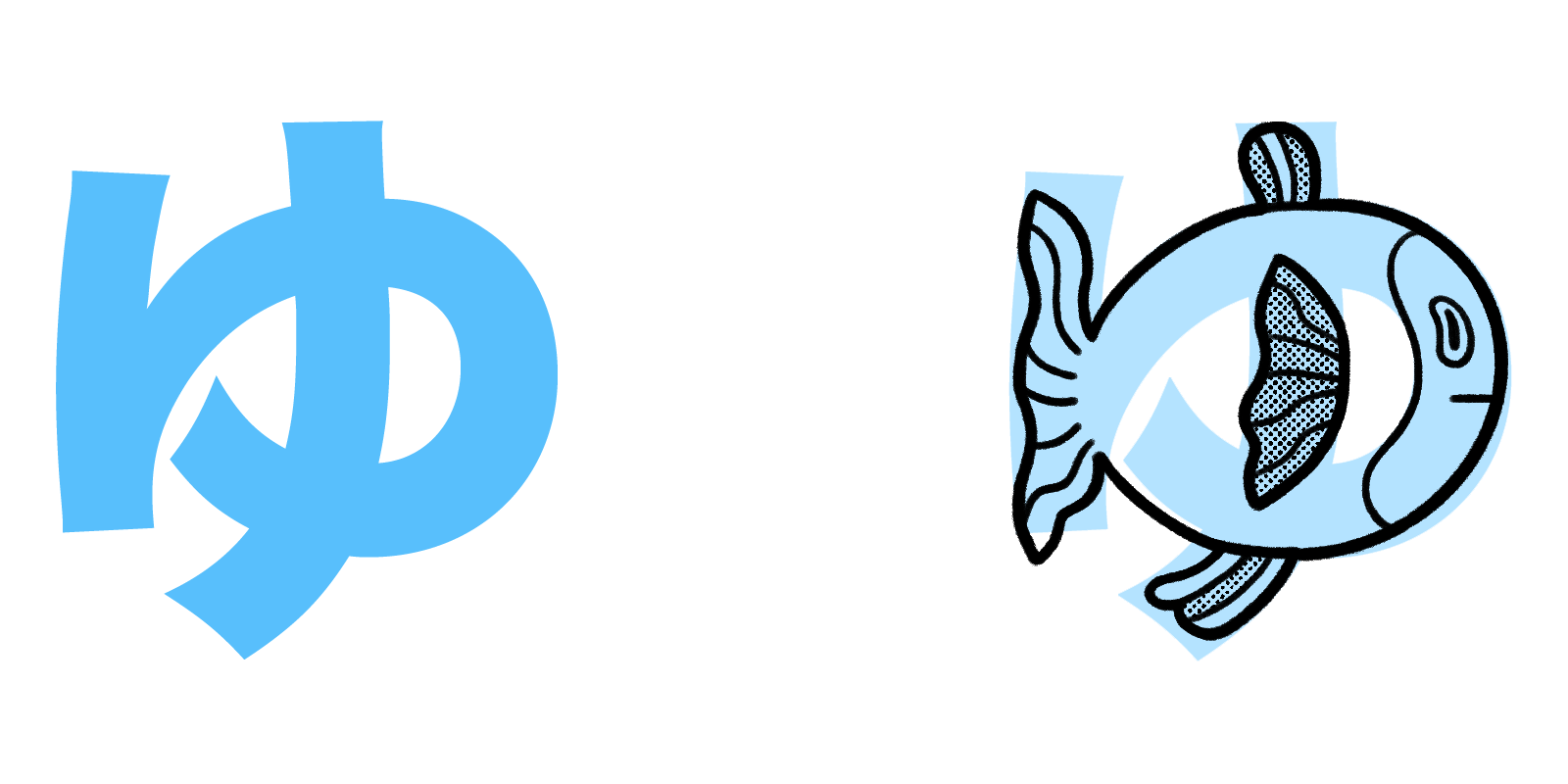
ゆ is just the Y sound plus う, making a yu sound. It’s pronounced like the English word “you.”
- ゆ
- YU
This kana is a very unique looking fish! It looks like a big eyeball swimming in the water. What’s it looking at? You, you big goofball! Isn’t it weird how fish always look like they’re staring at you?
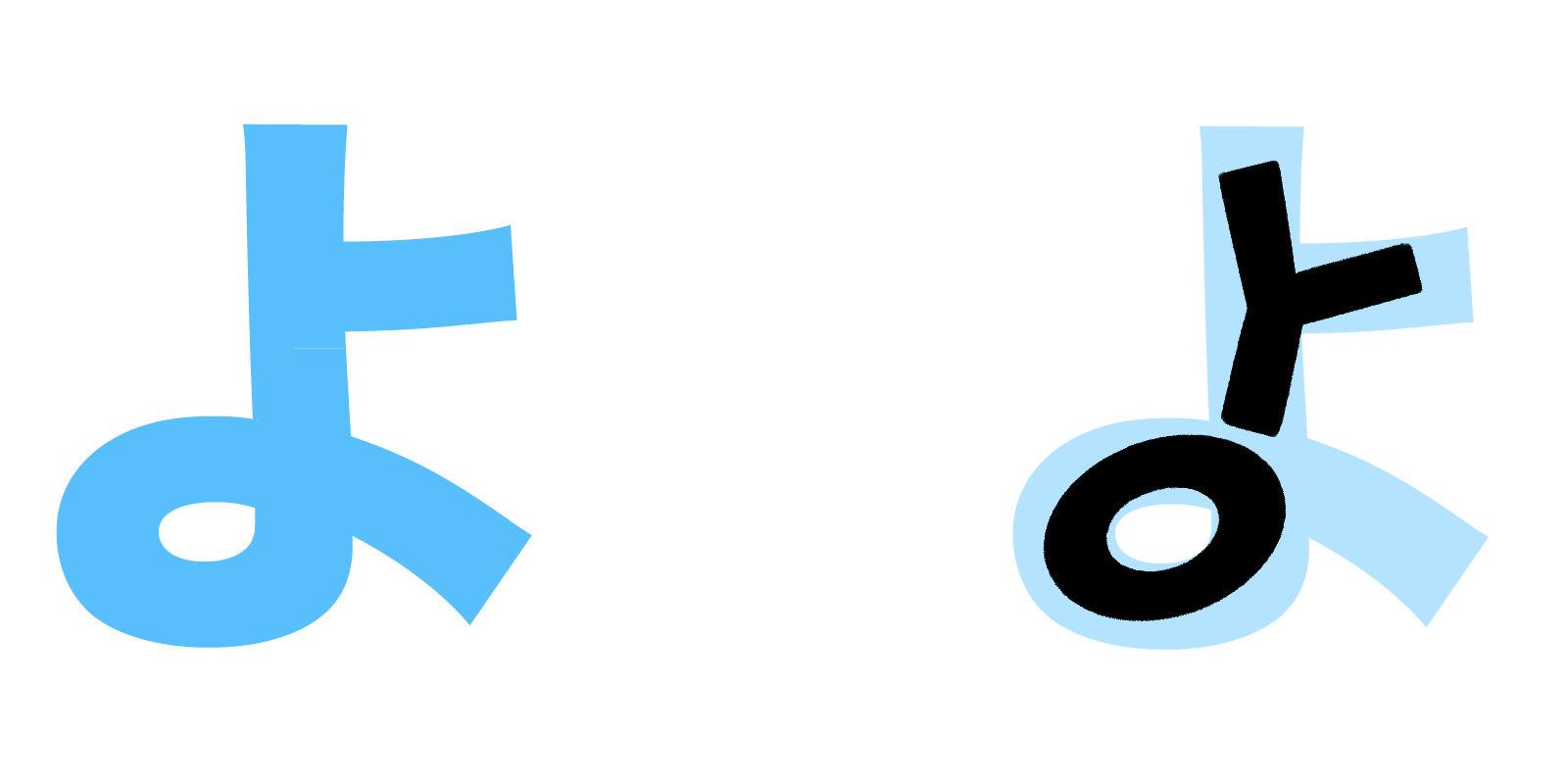
よ is just the Y sound plus お, making a yo sound. It’s pronounced like yo in “yo-yo.” In British English, it’s more like yo in “yonder.”
- よ
- YO
Yo, this kana looks like the letters Y & O! And look, you can even play yo-yo with it. Look at it slide down and back up again… it’s mesmerizing, yo.
まみむめもやゆよ Exercises
Time to practice these eight hiragana (and the previous ones as well). Once again, go through the steps to make sure you know everything well!
- Using Japanesguru Learn Hiragana Quiz, quiz yourself on the あ, か, さ, た, な, は, ま, and や columns. Once you’ve done this three times, move on to step two.
- Using this worksheet, copy, print out, or download it and write in all the boxes.
When you’re all done, it’s time to tackle the last “main hiragana” section. You’re almost there! Not so hard, right?
|
RA |
RI | RU | RE | RO |
| ら | り | る | れ |
ろ |
Welcome to the last main set! It’s only eight characters just like the last set, so hopefully it’s not too bad. It does include the infamous ra-ri-ru-re-ro column though, which does tend to give some people trouble pronunciation-wise. Please be sure to check out our “how to pronounce the Japanese R” article for more information on this.

ら is just the R / L sound plus あ, making a ra / la sound. It’s pronounced like a combination of “rah rah” (like cheering) and “la la la” (like singing!). To type or write it in romaji, use “r” and write “ra.” The same goes for the rest of the R column. Use “r” when writing in romaji!
- ら
- RA
ら looks like a rabbit that’s standing and facing left. Look at its big droopy ears. So cute!

り is just the R /L sound plus い, making a ri / li sound. It’s pronounced like a combination of ree in “reed” and lee in “leek.”
- り
- RI
The reeds are swaying in the wind.
This kana can also be written without the connection in the middle, too, which makes it more reedlike in that case (I wanted to present the more difficult of the two versions here, though).
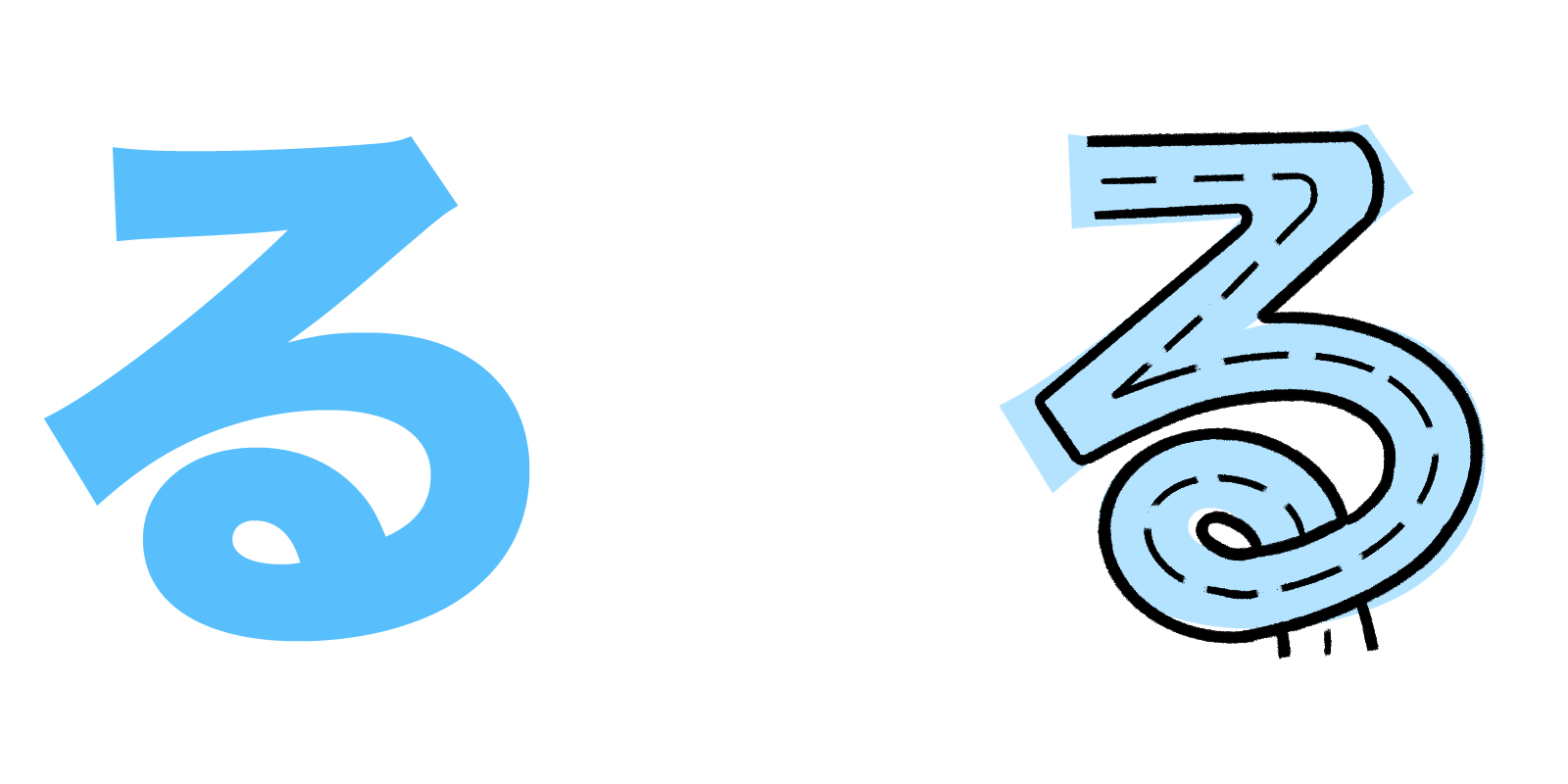
る is just the R / L sound plus う, making a ru / lu sound. It’s pronounced like a combination of ru in “rule” or “route” and loo in “loop.”
- る
- RU
The is like ろ (you’ll learn it in a second) except it has a loop at the end. る is a crazier route. There is a loop at the end. Are there no rules on this road?

れ is just the R /L sound plus え, making a re / le sound. It’s pronounced like a combination of re in “retch” and le in “led.”
- れ
- RE
This looks like a guy kneeling on the ground, retching up his dinner.
This kana is similar to め, わ, ぬ, and ね. What makes this one different is the curve at the back. You can identify this as the guy’s knees bending, which makes it clear that he’s keeled over retching his guts out.

ろ is just the R / L sound plus お, making a ro / lo sound. It’s pronounced like a combination of ro in “road” and lo in “load.” In British English, it’s more like ro in “rot” or lo in “long.”
- ろ
- RO
This is the counterpart to る, except this one doesn’t have a loop at the end. So this kana is just a plain old road.
|
WA |
WO | |||
| わ |
を |
And finally, the last group. This is a weird one. It includes わ (which is quite normal), を (which is pronounced just like お, but is primarily used as a particle), and ん (which is the only consonant-only character in all the kanaa). Let’s go through them one by one.

わ is just the W sound plus あ, making a wa sound. It’s pronounced like wa in “wasabi.”
- わ
- WA
This kana looks like a wasp flying straight up.
It looks similar to れ, ぬ, ね, and め. And it looks especially similar to ね. You know ね is Nelly the cat because of the curl of the tail on the end. So you can imagine the cat chasing this wasp, which is why it’s flying straight up to get away. Its butt is also a straight, sharp line. This is its stinger!

を is pronounced like o in “origami” — just like the vowel お. It used to be pronounced like “wo,” but now it sounds exactly like お. Why two kana for the o sound, you wonder? Unlike お, を is primarily used as a grammar element called a “particle.” It marks the object of a sentence.
In romaji, both “o” or “wo” are used for を. To type it, write “wo.”
- を
- WO
“Whoa!” yells the guy with no chin. Someone threw a boomerang into his mouth! That’s pretty “whoa“-worthy, I think.
|
N |
|
ん |
ん is just the N sound, that’s it. It’s the only kana that consists of a single consonant. It’s pronounced like the ending n sound in “pen.”
In romaji, write “n.” To type it, you sometimes have to type “nn.” Type double “n”s, especially before vowels and y, so that it won’t turn into another kana that starts with n.
- ん
- N
This kana looks just like the lowercase n in English. They happen to be the same sounds, as well. How convenient! nnnんんん.
Learn Hiragana Keyboard
If you want to learn Hiragana keyboard, you need basic fundamentals of the Japanese language include.
Japanese writing uses three types of characters: two syllabic alphabets (hiragana and katakana) and Chinese characters (kanji). Hiragana is used for grammar and native Japanese words. Katakana is for foreign words or to add emphasis.
In Japanese, sentences are arranged in a subject-object-verb (SOV) order, unlike English, which uses subject-verb-object (SVO).
There are two types of adjectives in Japanese: i-adjectives, which end in “i”, and na-adjectives, which need “na” when connected to a noun.
Japanese has a system of honorifics, which change how words are used depending on the speaker’s, listener’s, and others’ status.
Particles are small words that show the role of other words in a sentence. Some particles at the end of sentences add emotion, emphasis, or help form questions.
Nouns in Japanese do not have gender or number, and there are no articles like “a” or “the.”
Verbs are changed based on tense and voice, but not for different people.
Here are some common Japanese words:
- Konnichiwa: Hello
- Arigatou: Thank you
- Sumimasen: Excuse me or I’m sorry
- Hai: Yes
- Iie: No
- Ohayou gozaimasu: Good morning
- Konbanwa: Good evening
- Sayonara: Goodbye